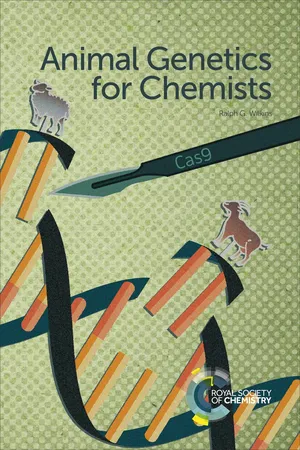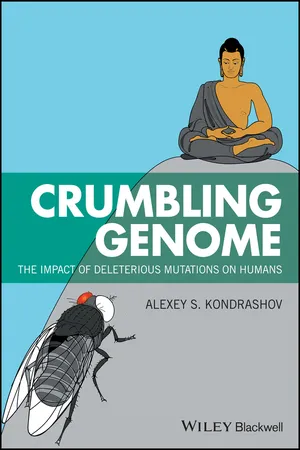Biological Sciences
Harmful Mutations
Harmful mutations are genetic alterations that can negatively impact an organism's phenotype, survival, or reproductive success. These mutations can lead to diseases, disorders, or reduced fitness, and are often eliminated from a population through natural selection. Harmful mutations are a key factor in understanding genetic diseases and evolutionary processes.
Written by Perlego with AI-assistance
Related key terms
3 Key excerpts on "Harmful Mutations"
- eBook - ePub
- David P. Clark(Author)
- 2009(Publication Date)
- Academic Cell(Publisher)
An error in a cell’s genetic material is known as a mutation. As might be expected, many mutations are detrimental. However, detrimental mutations tend to be overestimated because they are more noticeable. Very often the negative effect is minimal, and in fact, the majority of mutations have little or no significant effect on the survival of an organism—they are essentially neutral. Furthermore, occasional mutations may turn out to be beneficial to the survival and reproduction of the organism. The accumulation of such beneficial mutations allows the organism to evolve in response to changing environmental conditions (see Ch. 20). Mutations are heritable alterations in the genetic material of any organism or gene creature. At the molecular level, mutations are alterations in the DNA molecules of which the genes are made. Consequently, when a DNA molecule replicates, any changes due to mutation of the original DNA base sequence will be duplicated and passed on to the next generation of cells. In single-celled organisms, mutations are passed on from one generation to the next when the organism divides. Among multi-cellular organisms, the situation is more complicated. Mutations are inherited by the next generation of organisms only if they occur in the cells of the germ line and are passed on during sexual reproduction. Mutations that occur in somatic cells will only be passed on to the descendents of those cells. Such mutant cell lines will be restricted to the original multi-cellular organism where the mutation occurred. Somatic mutations that result in unregulated cell growth are responsible for the emergence of cancers. Other somatic mutations merely result in particular cell-lines or organs being genetically different from the rest of the body. Since the DNA is used as a template in transcription to make an RNA copy, a mutation in the DNA sequence within a cell will be passed on to the mRNA molecule. Finally, the mRNA is translated to yield protein - eBook - ePub
- Ralph G Wilkins(Author)
- 2017(Publication Date)
- Royal Society of Chemistry(Publisher)
CHAPTER 4 DNA Mutations and Their Impact on Human and Animal Phenotypes4.1 INTRODUCTION
This is a very important chapter encompassing all the varied changes that DNA can undergo and thereby produce faulty (mutant) genes and protein products. At the center of genetics, a mutation involves a functional change in the genetic material of a cell, specifically a change in the DNA or RNA sequences, and thus affects the sequence of amino acids in the resulting protein. If the change does not affect this sequence, it is a natural variant. A mutation is not necessarily irreversible, but if it involves somatic cells (acquired mutations), these will disappear when the owner dies. However, if the mutation involves the reproductive cells (germline mutation), an offspring may inherit the mutation in all its cells and have a hereditary ailment (inherited mutation). If after conception, growth and development of an embryo, only some cells have the mutation, mosaicism results.The frequency of mutations is rare and may be inherited or acquired during a person’s lifetime. Only a very small percentage of mutations cause genetic disorders, usually by altering or removing a critical encoded protein. The animal affected by the mutation (the mutant) may have discernible changes in the resulting phenotype, that is in its appearance, behavior or traits (disorders or diseases) compared with the wild-type animal, which has the phenotype most common in nature. The intensity of the phenotype change is likely to depend on the magnitude of the mutation, namely how much the DNA is changed or the chromosome involved. The mutation may arise as a random event during the formation of the egg or sperm, or in the early embryo (see Section 5.3 in Chapter 5 ), in which case there will have been no history of the disease in the family. Alternatively, it may be inherited from an affected parent.4.2 TYPES OF MUTATION
There is a wide range of types of alterations in DNA that lead to a mutation. Slight changes, involving only one or a few nucleotides, can only be detected by full sequencing techniques. On the other hand, whole chunks of DNA, involving millions of base pairs and even entire genes, may be lost or moved around within a chromosome or between chromosomes. These may be detected using karyotype patterns or by spectroscopic techniques (see FISH and SKY in Section 1.4.3 in Chapter 1 - eBook - ePub
Crumbling Genome
The Impact of Deleterious Mutations on Humans
- Alexey S. Kondrashov(Author)
- 2017(Publication Date)
- Wiley-Blackwell(Publisher)
4 Unavoidable MutationIn short, mutations are accidents, and accidents will happen.Alfred H. Sturtevant, 1937.The ultimate cause of all genetic variation is mutation, the appearance of random errors in DNA sequences. Most of individual mutations affect only short segments of genotypes, and single‐nucleotide substitutions and short deletions or insertions are particularly common. However, occasionally a mutation affects a very long DNA segment. Mutations can appear as singletons or as clusters. Under normal conditions, most mutations occur spontaneously, due to unavoidable errors in the course of DNA replication, repair, or recombination, and are not caused by any external influences. Apparently, natural selection tries to keep the rate of germline mutation in multicellular organisms as low as possible, without incurring too high a cost of DNA handling. It is not difficult to induce mutations by radiation or, even more efficiently, by chemical mutagens; in contrast, all attempts at germline antimutagenesis have been so far unsuccessful. Tools for active antimutagenesis by means of deliberate genotype modification are now in the early stages of development.4.1 Phenomenon of Mutation
In the review of genetics, presented in the previous three chapters, it was mentioned in passing that polymorphic loci originate as a result of mutation. This phenomenon is the root cause of the Main Concern, and now it is time to treat it in detail. Most generally, mutation (from the Latin mutatio meaning an alteration) is a process of appearance of changes in genotypes. Due to the discrete nature of DNA sequences, mutation consists of separate events, and each such event is also called a mutation. To add to the confusion, a new, altered, mutant DNA sequence, which emerges as the result of a mutation, is also called a mutation (Figure 4.1 )! And an individual that carries a de novo
Learn about this page
Index pages curate the most relevant extracts from our library of academic textbooks. They’ve been created using an in-house natural language model (NLM), each adding context and meaning to key research topics.


